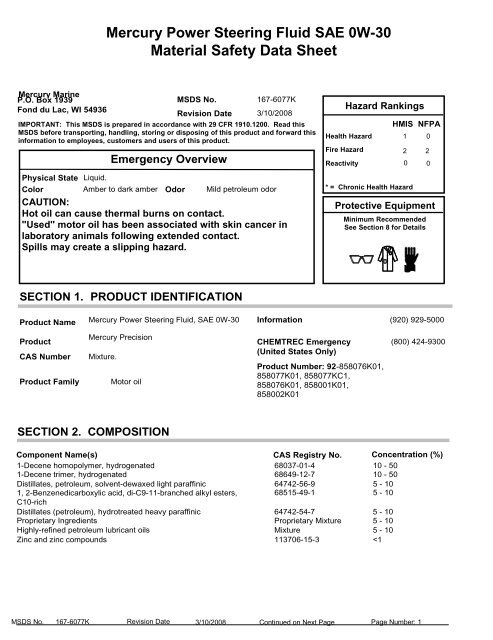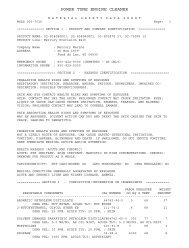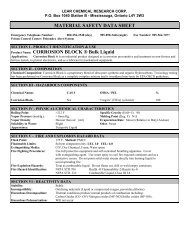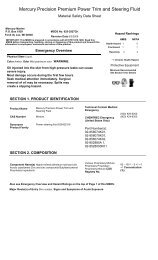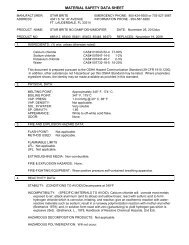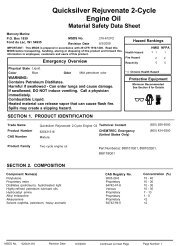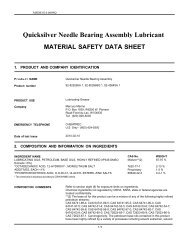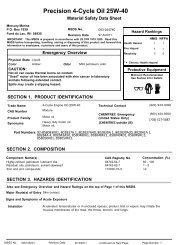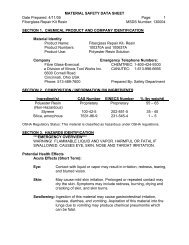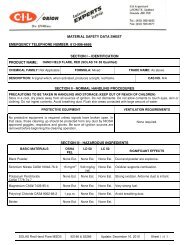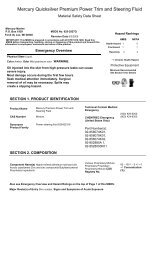Power Steering Fluid SAE 0W30 - Mercury Marine
Power Steering Fluid SAE 0W30 - Mercury Marine
Power Steering Fluid SAE 0W30 - Mercury Marine
Create successful ePaper yourself
Turn your PDF publications into a flip-book with our unique Google optimized e-Paper software.
<strong>Mercury</strong> <strong>Power</strong> <strong>Steering</strong> <strong>Fluid</strong> <strong>SAE</strong> 0W-30<br />
Material Safety Data Sheet<br />
<strong>Mercury</strong> <strong>Marine</strong><br />
P.O. Box 1939<br />
Fond du Lac, WI 54936<br />
MSDS No.<br />
Revision Date<br />
167-6077K<br />
3/10/2008<br />
IMPORTANT: This MSDS is prepared in accordance with 29 CFR 1910.1200. Read this<br />
MSDS before transporting, handling, storing or disposing of this product and forward this<br />
information to employees, customers and users of this product.<br />
Emergency Overview<br />
Physical State Liquid.<br />
Color Amber to dark amber Odor Mild petroleum odor<br />
CAUTION:<br />
Hot oil can cause thermal burns on contact.<br />
"Used" motor oil has been associated with skin cancer in<br />
laboratory animals following extended contact.<br />
Spills may create a slipping hazard.<br />
Hazard Rankings<br />
HMIS NFPA<br />
Health Hazard 1 0<br />
Fire Hazard 2 2<br />
Reactivity 0 0<br />
* = Chronic Health Hazard<br />
Protective Equipment<br />
Minimum Recommended<br />
See Section 8 for Details<br />
SECTION 1. PRODUCT IDENTIFICATION<br />
Product Name <strong>Mercury</strong> <strong>Power</strong> <strong>Steering</strong> <strong>Fluid</strong>, <strong>SAE</strong> 0W-30<br />
Information (920) 929-5000<br />
Product<br />
CAS Number<br />
Product Family<br />
<strong>Mercury</strong> Precision<br />
Mixture.<br />
Motor oil<br />
CHEMTREC Emergency<br />
(United States Only)<br />
Product Number: 92-858076K01,<br />
858077K01, 858077KC1,<br />
858076K01, 858001K01,<br />
858002K01<br />
(800) 424-9300<br />
SECTION 2. COMPOSITION<br />
Component Name(s)<br />
1-Decene homopolymer, hydrogenated<br />
1-Decene trimer, hydrogenated<br />
Distillates, petroleum, solvent-dewaxed light paraffinic<br />
1, 2-Benzenedicarboxylic acid, di-C9-11-branched alkyl esters,<br />
C10-rich<br />
Distillates (petroleum), hydrotreated heavy paraffinic<br />
Proprietary Ingredients<br />
Highly-refined petroleum lubricant oils<br />
Zinc and zinc compounds<br />
CAS Registry No.<br />
68037-01-4<br />
68649-12-7<br />
64742-56-9<br />
68515-49-1<br />
64742-54-7<br />
Proprietary Mixture<br />
Mixture<br />
113706-15-3<br />
Concentration (%)<br />
10 - 50<br />
10 - 50<br />
5 - 10<br />
5 - 10<br />
5 - 10<br />
5 - 10<br />
5 - 10<br />
<strong>Mercury</strong> <strong>Marine</strong> Synthetic Motor Oil, <strong>SAE</strong> 0W-30<br />
SECTION 3. HAZARDS IDENTIFICATION<br />
Also see Emergency Overview and Hazard Ratings on the top of Page 1 of this MSDS.<br />
Major Route(s) of Entry Skin contact.<br />
Signs and Symptoms of Acute Exposure<br />
Inhalation<br />
Eye Contact<br />
Skin Contact<br />
Ingestion<br />
Chronic Health Effects<br />
Summary<br />
Conditions Aggravated<br />
by Exposure<br />
Target Organs<br />
Carcinogenic Potential<br />
At elevated temperatures or in enclosed spaces, product mist or vapors may irritate the<br />
mucous membranes of the nose, the throat, bronchi, and lungs.<br />
This product can cause transient mild eye irritation with short-term contact with liquid sprays<br />
or mists. Symptoms include stinging, watering, redness, and swelling.<br />
This product can cause mild, transient skin irritation. Skin contact with hot material may<br />
result in severe burns.<br />
If swallowed, this material can cause a laxative effect.<br />
This product contains a petroleum-based mineral oil. Prolonged or repeated skin contact<br />
can cause mild irritation and inflammation characterized by drying, cracking, (dermatitis) or<br />
oil acne. Repeated or prolonged inhalation of petroleum-based mineral oil mists at<br />
concentrations above applicable workplace exposure levels can cause respiratory irritation or<br />
other pulmonary effects.<br />
Disorders of the following organs or organ systems that may be aggravated by significant<br />
exposure to this material or its components include: Skin<br />
May cause damage to the following organs: skin.<br />
This product is not known to contain any components at concentrations above 0.1% which<br />
are considered carcinogenic by OSHA, IARC or NTP.<br />
OSHA Hazard Classification is indicated by an "X" in the box adjacent to the hazard title. If no "X" is present,<br />
the product does not exhibit the hazard as defined in the OSHA Hazard Communication Standard (29 CFR<br />
1910.1200).<br />
OSHA Health Hazard Classification<br />
OSHA Physical Hazard Classification<br />
Irritant<br />
Toxic<br />
Corrosive<br />
Sensitizer<br />
Highly Toxic<br />
Carcinogenic<br />
Combustible Explosive Pyrophoric<br />
Flammable Oxidizer Water-reactive<br />
Compressed Gas Organic Peroxide Unstable<br />
SECTION 4. FIRST AID MEASURES<br />
Take proper precautions to ensure your own health and safety before attempting rescue or providing first aid.<br />
For more specific information, refer to Exposure Controls and Personal Protection in Section 8 of this MSDS.<br />
Inhalation<br />
Eye Contact<br />
Vaporization is not expected at ambient temperatures. This material is not expected to cause<br />
inhalation-related disorders under anticipated conditions of use. In case of overexposure,<br />
move the person to fresh air.<br />
Check for and remove contact lenses. Flush eyes with cool, clean, low-pressure water while<br />
occasionally lifting and lowering eyelids. Seek medical attention if excessive tearing, redness,<br />
or pain persists.<br />
MSDS No. 167-6077K Revision Date 3/10/2008 Continued on Next Page Page Number: 2
<strong>Mercury</strong> <strong>Marine</strong> Synthetic Motor Oil, <strong>SAE</strong> 0W-30<br />
Skin Contact<br />
Ingestion<br />
Notes to Physician<br />
If burned by hot material, cool skin by quenching with large amounts of cool water. For<br />
contact with product at ambient temperatures, remove contaminated shoes and clothing.<br />
Wipe off excess material. Wash exposed skin with mild soap and water. Seek medical<br />
attention if tissue appears damaged or if pain or irritation persists. Thoroughly clean<br />
contaminated clothing before reuse. Clean or discard contaminated leather goods. If material<br />
is injected under the skin, seek medical attention immediately.<br />
Do not induce vomiting unless directed to by a physician. Do not give anything to drink unless<br />
directed to by a physician. Never give anything by mouth to a person who is not fully<br />
conscious. Seek medical attention immediately.<br />
INGESTION: The viscosity range of the product(s) represented by this MSDS is greater than<br />
100 SUS at 100°F. Careful gastric lavage may be considered to evacuate large quantities of<br />
material.<br />
SECTION 5. FIRE FIGHTING MEASURES<br />
NFPA Flammability<br />
Classification<br />
Flash Point<br />
NFPA Class-IIIB combustible material.<br />
Closed cup: 186°C (367°F). (Pensky-Martens.) Open cup: 220°C (428°F) (Cleveland.).<br />
Lower Flammable Limit<br />
Autoignition<br />
Temperature<br />
Hazardous Combustion<br />
Products<br />
Special Properties<br />
Extinguishing Media<br />
Protection of Fire<br />
Fighters<br />
No data.<br />
Not available.<br />
Upper Flammable Limit<br />
No data.<br />
Carbon dioxide, carbon monoxide, smoke, fumes, unburned hydrocarbons and oxides of<br />
sulfur, phosphorus, zinc and/or nitrogen.<br />
This material can burn but will not readily ignite. This material will release vapors when<br />
heated above the flash point temperature that can ignite when exposed to a source of<br />
ignition. In enclosed spaces, heated vapor can ignite with explosive force. Mists or sprays<br />
may burn at temperatures below the flash point.<br />
Use dry chemical, foam, carbon dioxide or water fog. Water or foam may cause frothing.<br />
Carbon dioxide and inert gas can displace oxygen. Use caution when applying carbon<br />
dioxide or inert gas in confined spaces.<br />
Firefighters must use full bunker gear including NIOSH-approved positive pressure<br />
self-contained breathing apparatus to protect against potential hazardous combustion or<br />
decomposition products and oxygen deficiencies.<br />
SECTION 6. ACCIDENTAL RELEASE MEASURES<br />
Take proper precautions to ensure your own health and safety before attempting spill control or clean-up. For<br />
more specific information, refer to the Emergency Overview on Page 1, Exposure Controls and Personal<br />
Protection in Section 8 and Disposal Considerations in Section 13 of this MSDS.<br />
Do not touch damaged containers or spilled material unless wearing appropriate protective<br />
equipment. Slipping hazard; do not walk through spilled material. Stop leak if you can do so<br />
without risk. For small spills, absorb or cover with dry earth, sand, or other inert<br />
non-combustible absorbent material and place into waste containers for later disposal.<br />
Contain large spills to maximize product recovery or disposal. Prevent entry into waterways or<br />
sewers. In urban area, cleanup spill as soon as possible. In natural environments, seek<br />
cleanup advice from specialists to minimize physical habitat damage. This material will float<br />
on water. Absorbent pads and similar materials can be used. Comply with all laws and<br />
regulations.<br />
MSDS No. 167-6077K Revision Date 3/10/2008 Continued on Next Page Page Number: 3
<strong>Mercury</strong> <strong>Marine</strong> Synthetic Motor Oil, <strong>SAE</strong> 0W-30<br />
SECTION 7.<br />
Handling<br />
Storage<br />
HANDLING AND STORAGE<br />
Avoid contamination and extreme temperatures to minimize product degradation. Empty<br />
containers may contain product residues that can ignite with explosive force. Do not<br />
pressurize, cut, weld, braze solder, drill, grind or expose containers to flames, sparks, heat or<br />
other potential ignition sources. Consult appropriate federal, state and local authorities before<br />
reusing, reconditioning, reclaiming, recycling or disposing of empty containers and/or waste<br />
residues of this product.<br />
Keep container closed. Store in a cool, dry, well-ventilated area. Do not store with strong<br />
oxidizing agents. Do not store at elevated temperatures. Avoid storing product in direct<br />
sunlight for extended periods of time. Consult appropriate federal, state and local authorities<br />
before reusing, reconditioning, reclaiming, recycling or disposing of empty containers or waste<br />
residues of this product.<br />
SECTION 8. EXPOSURE CONTROLS AND PERSONAL PROTECTION<br />
Engineering Controls<br />
Personal Protective<br />
Equipment<br />
Provide exhaust ventilation or other engineering controls to keep the airborne concentrations<br />
of mists and/or vapors below the recommended exposure limits (see below). An eye wash<br />
station and safety shower should be located near the work-station.<br />
Personal protective equipment should be selected based upon the conditions under which<br />
this material is used. A hazard assessment of the work area for PPE requirements should<br />
be conducted by a qualified professional pursuant to OSHA regulations. The following<br />
pictograms represent the minimum requirements for personal protective equipment. For<br />
certain operations, additional PPE may be required.<br />
Eye Protection<br />
Hand Protection<br />
Body Protection<br />
Respiratory Protection<br />
General Comments<br />
Occupational Exposure Guidelines<br />
Safety glasses equipped with side shields are recommended as minimum protection in<br />
industrial settings. Wear goggles if splashing or spraying is anticipated. Wear goggles and<br />
face shield if material is heated above 125°F (51°C). Have suitable eye wash water<br />
available.<br />
None required for incidental contact. Use gloves constructed of chemical resistant materials<br />
such as heavy nitrile rubber if frequent or prolonged contact is expected. Use<br />
heat-protective gloves when handling product at elevated temperatures.<br />
Avoid prolonged or repeated skin contact. Use clean protective clothing if splashing or<br />
spraying conditions are present such as long-sleeved garment. Remove oil contaminated<br />
clothing and launder before reuse. Heavily contaminated clothing and leather goods should<br />
be removed promptly and cleaned or discarded.<br />
The need for respiratory protection is not anticipated under normal use conditions and with<br />
adequate ventilation. If elevated airborne concentrations above applicable workplace<br />
exposure levels are anticipated, a NIOSH-approved organic vapor respirator equipped with a<br />
dust/mist prefilter should be used. Protection factors vary depending upon the type of<br />
respirator used. Respirators should be used in accordance with OSHA requirements (29<br />
CFR 1910.134).<br />
Use good personal hygiene practices. Wash hands and other exposed skin areas with<br />
plenty of mild soap and water before eating, drinking, smoking, use of toilet facilities, or<br />
leaving work. DO NOT use gasoline, kerosene, solvents or harsh abrasives as skin<br />
cleaners. Since specific exposure standards/control limits have not been established for this<br />
product, the "Oil Mist, Mineral" exposure limits shown below are suggested as minimum<br />
control guidelines.<br />
MSDS No. 167-6077K Revision Date 3/10/2008 Continued on Next Page Page Number: 4
<strong>Mercury</strong> <strong>Marine</strong> Synthetic Motor Oil, <strong>SAE</strong> 0W-30<br />
Substance<br />
Oil Mist, Mineral<br />
Applicable Workplace Exposure Levels<br />
ACGIH (United States).<br />
TWA: 5 mg/m 3<br />
STEL: 10 mg/m 3<br />
OSHA (United States).<br />
TWA: 5 mg/m 3<br />
SECTION 9.<br />
PHYSICAL AND CHEMICAL PROPERTIES (TYPICAL)<br />
Physical State<br />
Liquid.<br />
Color<br />
Specific Gravity 0.86 (Water = 1) pH<br />
Boiling Range<br />
Not available.<br />
Amber to dark<br />
amber<br />
Not applicable<br />
Odor<br />
Vapor<br />
Density<br />
Melting/Freezing<br />
Point<br />
Mild petroleum odor<br />
>1 (Air = 1)<br />
Not available.<br />
Vapor Pressure 2000 mg/kg [Rabbit].<br />
Practically non-irritating to eyes. Practically non-irritating to the skin.<br />
Distillates, petroleum, solvent-dewaxed light paraffini:c<br />
ORAL (LD50): Acute: >5000 mg/kg [Rat].<br />
DERMAL (LD50): Acute: >2000 mg/kg [Rabbit].<br />
Mineral oil mists derived from highly refined oils are reported to have low acute and sub-acute<br />
toxicities in animals. Effects from single and short-term repeated exposures to high<br />
concentrations of mineral oil mists well above applicable workplace exposure levels include<br />
lung inflammatory reaction, lipoid granuloma formation and lipoid pneumonia. In acute and<br />
sub-acute studies involving exposures to lower concentrations of mineral oil mists at or near<br />
MSDS No. 167-6077K Revision Date 3/10/2008 Continued on Next Page Page Number: 5
<strong>Mercury</strong> <strong>Marine</strong> Synthetic Motor Oil, <strong>SAE</strong> 0W-30<br />
current work place exposure levels produced no significant toxicological effects. In long term<br />
studies (up to two years) no carcinogenic effects have been reported in any animal species<br />
tested.<br />
Di-isodecyl phthalate:<br />
ORAL (LD50):<br />
DERMAL (LD50):<br />
Acute: >2000 mg/kg [Rat].<br />
Acute: >2000 mg/kg [Rabbit].<br />
Practically non-irritating to eyes and to the skin. Practically non-toxic by inhalation (LC 50<br />
>5mg/L) based on testing of similar products in rats. A 2-generation reproductive toxicity<br />
study conducted on this material did not identify any effects on reproductive parameters.<br />
However, the study did identify a small increase in early offspring mortality at the high oral<br />
dose level. Based on studies with laboratory animals, oral maternal exposure to this<br />
component can result in developmental toxicity to the conceptus. The NOAELs established<br />
from these studies were 38 to 44 mg/kg-bw/day during pregnancy and 52 to 114<br />
mg/kg-bw/day during lactation.<br />
Distillates (petroleum), hydrotreated heavy paraffin:ic<br />
ORAL (LD50): Acute: >5000 mg/kg [Rat].<br />
DERMAL (LD50): Acute: >2000 mg/kg [Rabbit].<br />
Mineral oil mists derived from highly refined oils are reported to have low acute and sub-acute<br />
toxicities in animals. Effects from single and short-term repeated exposures to high<br />
concentrations of mineral oil mists well above applicable workplace exposure levels include<br />
lung inflammatory reaction, lipoid granuloma formation and lipoid pneumonia. In acute and<br />
sub-acute studies involving exposures to lower concentrations of mineral oil mists at or near<br />
current work place exposure levels produced no significant toxicological effects. In long term<br />
studies (up to two years) no carcinogenic effects have been reported in any animal species<br />
tested.<br />
Engine oil:<br />
Used motor oil was associated with cancer in lifetime skin painting studies with laboratory<br />
animals. Avoid prolonged or repeated contact with used motor oil. Use of good hygiene<br />
practices will reduce the liklihood of potential health effects.<br />
SECTION 12. ECOLOGICAL INFORMATION<br />
Ecotoxicity<br />
Environmental Fate<br />
Analysis for ecological effects has not been conducted on this product. However, if spilled,<br />
this product and any contaminated soil or water may be harmful to human, animal, and<br />
aquatic life. Also, the coating action associated with petroleum and petroleum products can<br />
be harmful or fatal to aquatic life and waterfowl.<br />
An environmental fate analysis is not available for this specific product. Plants and animals<br />
may experience harmful or fatal effects when coated with petroleum products.<br />
Petroleum-based (mineral) lubricating oils normally will float on water. In stagnant or<br />
slow-flowing waterways, an oil layer can cover a large surface area. As a result, this oil layer<br />
might limit or eliminate natural atmospheric oxygen transport into the water. With time, if not<br />
removed, oxygen depletion in the waterway may be sufficient to cause a fish kill or create an<br />
anaerobic environment. This material contains phosphorus which is a controlled element for<br />
disposal in effluent waters in most sections of North America. Phosphorus is known to<br />
enhance the formation of algae. Severe algae growth can reduce oxygen content in the<br />
water possibly below levels necessary to support marine life.<br />
MSDS No. 167-6077K Revision Date 3/10/2008 Continued on Next Page Page Number: 6
<strong>Mercury</strong> <strong>Marine</strong> Synthetic Motor Oil, <strong>SAE</strong> 0W-30<br />
SECTION 13. DISPOSAL CONSIDERATIONS<br />
Hazard characteristic and regulatory waste stream classification can change with product use. Accordingly, it is<br />
the responsibility of the user to determine the proper storage, transportation, treatment and/or disposal<br />
methodologies for spent materials and residues at the time of disposition.<br />
Conditions of use may cause this material to become a "hazardous waste", as defined by<br />
federal or state regulations. It is the responsibility of the user to determine if the material is a<br />
"hazardous waste" at the time of disposal. Transportation, treatment, storage, and disposal<br />
of waste material must be conducted in accordance with RCRA regulations (see 40 CFR 260<br />
through 40 CFR 271). State and/or local regulations may be more restrictive. Contact your<br />
regional US EPA office for guidance concerning case specific disposal issues. Empty drums<br />
and pails retain residue. DO NOT pressurize, cut, weld, braze, solder, drill, grind, or expose<br />
this product's empty container to heat, flame, or other ignition sources. DO NOT attempt to<br />
clean it. Empty drums and pails should be drained completely, properly bunged or sealed,<br />
and promptly sent to a reconditioner.<br />
SECTION 14. TRANSPORT INFORMATION<br />
The shipping description below may not represent requirements for all modes of transportation, shipping<br />
methods or locations outside of the United States.<br />
US DOT Status<br />
Proper Shipping Name<br />
Hazard Class<br />
Reportable Quantity<br />
Placard(s)<br />
Not regulated by the U.S. Department of Transportation as a hazardous material.<br />
Not regulated.<br />
Not regulated.<br />
Packing Group<br />
UN/NA Number<br />
A Reportable Quantity (RQ) has not been established for this material.<br />
Emergency Response<br />
Guide No.<br />
MARPOL III Status<br />
Not applicable.<br />
Not regulated.<br />
Not applicable.<br />
Not a DOT "<strong>Marine</strong><br />
Pollutant" per 49 CFR<br />
171.8.<br />
Oil: The product(s) represented by this MSDS is (are)<br />
regulated as “oil” under 49 CFR Part 130. Shipments by<br />
rail or highway in packaging having a capacity of 3500<br />
gallons or more or in a quantity greater 42,000 gallons<br />
are subject to these requirements. In addition, mixtures<br />
containing 10% or more of this product may be subject to<br />
these requirements.<br />
SECTION 15.<br />
REGULATORY INFORMATION<br />
TSCA Inventory<br />
SARA 302/304<br />
Emergency Planning<br />
and Notification<br />
SARA 311/312 Hazard<br />
Identification<br />
This product and/or its components are listed on the Toxic Substances Control Act (TSCA)<br />
inventory.<br />
The Superfund Amendments and Reauthorization Act of 1986 (SARA) Title III requires<br />
facilities subject to Subparts 302 and 304 to submit emergency planning and notification<br />
information based on Threshold Planning Quantities (TPQs) and Reportable Quantities<br />
(RQs) for "Extremely Hazardous Substances" listed in 40 CFR 302.4 and 40 CFR 355. No<br />
components were identified.<br />
The Superfund Amendments and Reauthorization Act of 1986 (SARA) Title III requires<br />
facilities subject to this subpart to submit aggregate information on chemicals by "Hazard<br />
Category" as defined in 40 CFR 370.2. This material would be classified under the following<br />
hazard categories:<br />
No SARA 311/312 hazard categories identified.<br />
MSDS No. 167-6077K Revision Date 3/10/2008 Continued on Next Page Page Number: 7
<strong>Mercury</strong> <strong>Marine</strong> Synthetic Motor Oil, <strong>SAE</strong> 0W-30<br />
SARA 313 Toxic<br />
Chemical Notification<br />
and Release Reporting<br />
CERCLA<br />
Clean Water Act<br />
(CWA)<br />
California<br />
Proposition 65<br />
New Jersey<br />
Right-to-Know Label<br />
Additional Remarks<br />
This product contains the following components in concentrations above de minimis levels<br />
that are listed as toxic chemicals in 40 CFR Part 372 pursuant to the requirements of Section<br />
313 of SARA: No components were identified.<br />
The Comprehensive Environmental Response, Compensation, and Liability Act of 1980<br />
(CERCLA) requires notification of the National Response Center concerning release of<br />
quantities of "hazardous substances" equal to or greater than the reportable quantities (RQ's)<br />
listed in 40 CFR 302.4. As defined by CERCLA, the term "hazardous substance" does not<br />
include petroleum, including crude oil or any fraction thereof which is not otherwise<br />
specifically designated in 40 CFR 302.4. Chemical substances present in this product or<br />
refinery stream that may be subject to this statute are:<br />
Zinc and zinc compounds, Concentration:
<strong>Mercury</strong> <strong>Marine</strong> Synthetic Motor Oil, <strong>SAE</strong> 0W-30<br />
ARISING OUT OF OR IN ANY WAY CONNECTED WITH HANDLING, STORAGE, USE OR DISPOSAL OF THE<br />
PRODUCT.<br />
* * * * * END OF MSDS * * * * *


